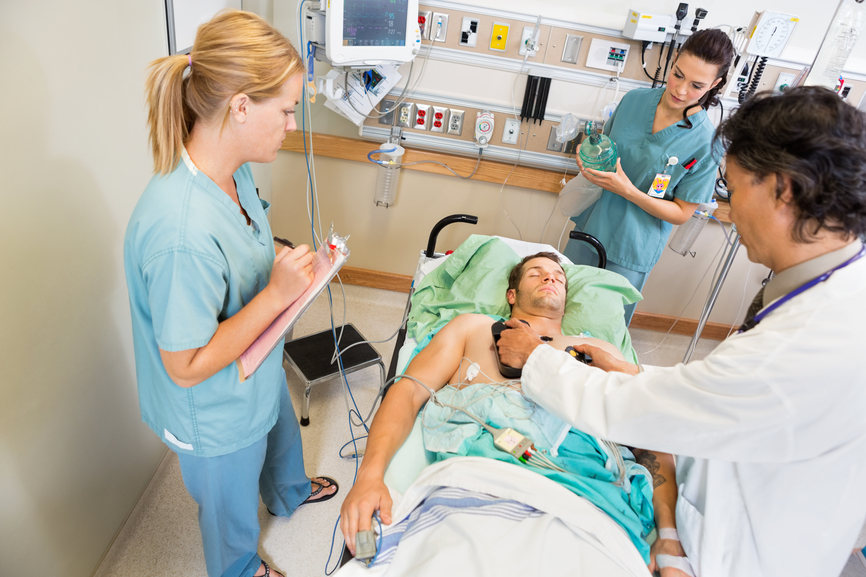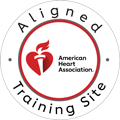The Critical Role of Shockable Rhythms
Sudden cardiac arrest is a devastating medical emergency, and the difference between life and death often hinges on immediate recognition and intervention. Statistics on sudden cardiac arrest survival rates outside of a hospital remain sobering, highlighting the urgent need for proficient emergency response.
A shockable rhythm refers to a specific type of abnormal heart activity that can be corrected by an electrical shock from a defibrillator, effectively stopping the chaotic electrical activity and allowing the heart’s natural pacemaker to restart a normal rhythm. For any healthcare provider, understanding the nuances of these rhythms is not merely academic; it is absolutely critical, as proper identification dictates the entire course of resuscitation and dramatically improves the patient’s prognosis.

Understanding Cardiac Rhythms Fundamentals
Before diving into the specific shockable rhythms, it is essential to review the fundamentals of how the heart works.
Normal Heart Rhythm Basics
The normal heart rhythm, known as normal sinus rhythm, relies on a finely tuned electrical conduction system that coordinates the contraction of the atria and ventricles. This system ensures efficient pumping of blood throughout the body. However, diseases or trauma can cause this delicate electrical system to malfunction, leading to disorganized or absent contractions that quickly result in cardiac arrest.
Cardiac Arrest vs. Heart Attack
It is also important to differentiate between cardiac arrest and a heart attack. A heart attack, or myocardial infarction, is typically a circulation problem caused by a blocked artery, while cardiac arrest is an electrical problem where the heart stops beating effectively. While a heart attack can certainly cause cardiac arrest, rhythm recognition is key because the treatment protocols are vastly different for the underlying electrical issue.
The Critical Nature of Time
When the heart stops, time becomes the most critical factor, a concept formalized in the “chain of survival.” For every minute that passes without intervention after sudden cardiac arrest, the probability of survival decreases significantly. This stark reality emphasizes why immediate action is paramount. Statistics clearly show that initiating high-quality cardiopulmonary resuscitation, or CPR, and providing prompt defibrillation with an electrical shock offers the patient the best chance of survival. Simply put, delay equals death in this scenario, cementing the necessity of rapid rhythm analysis and intervention.
Call Us Now
Get the Best CPR Class in Kansas City Today!
The Two Primary Shockable Rhythms
The vast majority of reversible sudden cardiac arrests are caused by one of two primary shockable rhythms. The first is Ventricular Fibrillation, or VF. This rhythm is characterized by completely chaotic electrical activity within the heart’s lower chambers, the ventricles. Instead of pumping, the ventricles merely quiver, resulting in no measurable blood flow and therefore no pulse.
Ventricular Fibrillation (VF)
On an EKG, VF is immediately recognizable as irregular, rapid oscillations with absolutely no identifiable P waves, QRS complexes, or T waves. Practitioners will sometimes distinguish between coarse VF, which has larger amplitude waves and may be more responsive to shock, and fine VF, which has smaller waves and can sometimes be mistaken for the non-shockable rhythm asystole. Clinically, a patient experiencing VF will suffer sudden collapse, will not be breathing, and will have a complete loss of consciousness due to the immediate lack of blood circulation to the brain. Because the heart is capable of pumping if the electrical chaos is stopped, VF has the best prognosis of all cardiac arrest rhythms, provided it is treated immediately with an electrical shock.
Ventricular Tachycardia (VT)
The second critical shockable rhythm is Ventricular Tachycardia, or VT. This rhythm is a rapid heart rate that originates from an ectopic focus below the AV node within the ventricles. When the ventricular rate is too fast, the heart chambers do not have enough time to fill with blood between beats, compromising cardiac output. VT exists in several forms, including stable VT, where the patient still has a pulse and is hemodynamically stable, unstable VT, where the patient has a pulse but is showing signs of shock, and Pulseless VT, which is treated the same way as ventricular fibrillation because the patient is in cardiac arrest. EKG characteristics of VT include wide QRS complexes, defined as greater than 120 milliseconds, and a ventricular rate typically ranging between 150 and 250 beats per minute. The rhythm can be regular or slightly irregular. The clinical presentation varies depending on the type; patients with pulseless VT present the same as those in VF, while patients with unstable VT may complain of chest pain, difficulty breathing, or an altered mental status. For emergency intervention, VT becomes a shockable rhythm when the patient is pulseless or shows signs of hemodynamic instability that cannot be quickly reversed.
Key Differences and Similarities
Both ventricular fibrillation and pulseless ventricular tachycardia require immediate defibrillation because they represent electrical instability that prevents effective pumping of blood. Both are forms of cardiac arrest, and both demand the urgent application of the Advanced Cardiac Life Support, or ACLS, algorithm. Though both are treated with a shock when pulseless, they are differentiated on the monitor by their EKG characteristics. VF is chaotic and disorganized, while VT maintains a somewhat regular, though rapid, pattern of wide QRS complexes. The immediate treatment priority for both, once recognized and confirmed pulseless, is the delivery of a high-energy electrical shock.
Non-Shockable Rhythms
Pulseless Electrical Activity (PEA)
In contrast to these life-threatening instabilities, there are two primary non-shockable rhythms that healthcare providers must also be proficient at recognizing. The first is Pulseless Electrical Activity, or PEA. In this condition, the heart’s electrical system is working and the cardiac monitor displays a recognizable rhythm, but the heart muscle is not contracting forcefully enough to generate a pulse or blood pressure. Since defibrillation works by resetting chaotic electrical activity, an electrical shock is ineffective in PEA. The focus of resuscitation shifts entirely to identifying and reversing the underlying causes, commonly referred to as the H’s and T’s.
Asystole
The second non-shockable rhythm is Asystole, the infamous “flatline.” This rhythm represents a complete lack of measurable electrical activity and mechanical contraction in the heart. While it should be confirmed across two different EKG leads to rule out a detached electrode, a true asystole tracing means the electrical system has failed. Unlike the shockable rhythms, the treatment approach for asystole does not include defibrillation but instead focuses on high-quality CPR and the administration of epinephrine.
Why Recognition Matters
Ultimately, recognition matters immensely because the different rhythms demand different protocols, helping to avoid inappropriate shocks that waste critical time and instead keeping the focus on effective CPR and the search for reversible causes in the case of non-shockable rhythms.
Defibrillation: The Life-Saving Intervention
Defibrillation is truly the life-saving intervention for shockable rhythms, acting as a global reset button for the heart’s electrical system. The electrical principles involve passing a controlled electrical current through the chest, which momentarily depolarizes a critical mass of the heart muscle, or myocardium. This simultaneous depolarization effectively terminates the chaotic rhythm, allowing the heart’s natural pacemaker, the sinoatrial node, to potentially resume a normal, organized rhythm.
Types of Defibrillators
Various types of defibrillators are used in practice, ranging from manual defibrillators used by trained personnel in hospitals and ambulances to the ubiquitous Automated External Defibrillators, or AEDs, found in public places, and finally, Implantable Cardioverter-Defibrillators, or ICDs, which are surgically placed in patients at high risk.
Energy Levels and Waveforms
Modern devices utilize biphasic waveforms, which deliver energy more efficiently at lower joule settings than older monophasic devices. Whether the energy is selected manually or automatically by an AED, the goal remains the same: deliver enough energy to stop the electrical storm.
Safety Considerations
Safety considerations are paramount during this intervention, necessitating strict adherence to “Clear” protocols to ensure no one is touching the patient during the shock, as well as proper pad placement to maximize current flow across the myocardium and minimize hands-off time.
Recognition and Response in Clinical Practice
Rapid Assessment Protocol
The application of this knowledge in a real-world clinical practice setting requires a swift, coordinated effort, beginning with a rapid assessment protocol. This involves quickly checking the patient’s responsiveness, assessing breathing, and, for healthcare providers, performing a pulse check simultaneously with monitor interpretation.
ACLS Algorithm Application
The entire process of resuscitation is guided by the ACLS algorithm, which mandates immediate CPR initiation if no pulse is found, followed by rapid rhythm analysis and the selection of the appropriate intervention, whether that is a shock for VF or pulseless VT, or drug therapy and PEA investigation.
Team Coordination
Effective team coordination is crucial, requiring clear role assignments, precise communication during the resuscitation effort, and meticulous post-shock assessment. Continuous quality indicators, such as proper compressions between shocks, minimizing hands-off time, and effective ventilation, are constantly monitored to ensure the best patient care.
FAQs About Shockable Rhythms
- What exactly are shockable rhythms? Shockable rhythms are two life-threatening heart rhythms—ventricular fibrillation (VF) and pulseless ventricular tachycardia (VT)—that can be treated with defibrillation. In these rhythms, the heart’s electrical activity becomes chaotic or dangerously fast, preventing effective blood circulation. The good news is that delivering an electrical shock through an AED or defibrillator can potentially restore a normal heart rhythm and save a life.
- How can I recognize a shockable rhythm in an emergency? As a bystander, you won’t need to identify the specific rhythm—that’s what an AED does for you. When you attach AED pads to a person in cardiac arrest, the device automatically analyzes the heart rhythm and tells you whether a shock is advised. However, healthcare providers learn to recognize these rhythms on a cardiac monitor during ACLS training, identifying the distinctive patterns of VF (chaotic, disorganized waveforms) and pulseless VT (rapid, wide, regular complexes).
- What should I do if someone collapses and might need defibrillation? Call 911 immediately, then start CPR with chest compressions. If an AED is available, turn it on and follow the voice prompts—it will guide you through every step. Continue CPR between shocks as directed until emergency responders arrive. Remember, you can’t harm someone by using an AED; it only delivers a shock if a shockable rhythm is detected. Quick action combining CPR and early defibrillation dramatically increases survival chances.
- Why is it important to learn about shockable rhythms? Understanding shockable rhythms empowers you to respond confidently during cardiac emergencies. For healthcare providers, recognizing these rhythms is essential for delivering advanced life support. For the general public, knowing that immediate CPR and AED use can reverse these deadly rhythms motivates people to act rather than freeze in an emergency. Every minute without defibrillation decreases survival chances by 7-10%, making your knowledge and quick response truly lifesaving.
Call to Action
Don’t wait until an emergency happens—be prepared to save a life today. Whether you’re a healthcare professional needing advanced training or a community member who wants to be ready, CPR Kansas City has the certification course for you. Our American Heart Association ACLS classes in Kansas City teach healthcare providers to recognize and treat shockable rhythms with confidence, while our CPR certification in Kansas City empowers everyone with lifesaving skills. All our classes are stress-free, hands-on, and taught by experienced instructors. Enroll now and become someone’s hero tomorrow!


